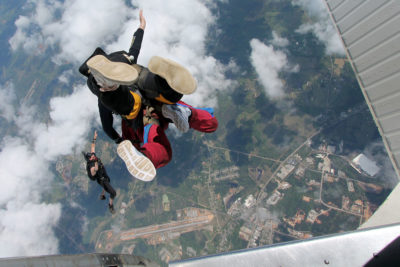Either through television and film or a little personal research, it’s likely you’ve come across the term HALO skydiving and if you haven’t, no worries, that’s what we are here for! Simply put, the acronym HALO stands for High Altitude Low Opening. Now, technically speaking, high altitude skydiving can refer to any skydive made above 15,000 feet. But, when it comes right down to it, there are quite a few key differences between the type of HALO skydiving that is done by the military and the type of high altitude skydiving that is done by civilian skydivers. Here’s the skinny on HALO skydiving.

Military HALO Skydiving
In the case of military HALO skydiving, the primary objective is stealth. Typically, HALO skydiving is used to insert troops and equipment into potentially hostile zones. When an area is unsuitable for an aircraft landing, the special forces HALO jumpers are called in. Aside from the intention of the HALO skydive, one of the primary differences between military and civilian high altitude skydiving is exit altitude and the parachute deployment altitude. On a military high-altitude skydive, the typical exit altitude is between 30,000 and 40,000 feet. The opening altitude (or the altitude at which the parachute is deployed) can be as low as 800 feet.
Military jumpers may also use something called a HAHO jump as a method of tactical insertion. On a HAHO (High Altitude High Opening) jump, individuals exit from a high altitude and almost immediately deploy their parachutes. Using navigation technology and maneuverable parachutes, these individuals are able to cover significant distances (30+ miles).
Civilian HALO Skydiving
The term HALO skydiving is commonly used by dropzones to mean any skydive with an altitude over 15,000 feet. Though the opening altitude is quite low with military HALO skydiving, licensed civilian skydivers completing a high altitude skydive will still deploy their parachutes at the same altitude they would on a regular skydive. Usually, this is between 3,000 and 4,000 feet. Tandem HALO skydivers will also deploy the parachute at the standard deployment altitude between 5,500 and 6,000 feet.
So, why would someone want to do a civilian high-altitude skydive? In truth, the difference between a civilian HALO skydive and a typical tandem from 14,000 feet comes down to a matter of seconds. To see a real difference in the amount of freefall time you would get to experience, you would need to reach at least 18,000 feet. Exiting from this height would add an additional 30 seconds of freefall.
HALO Skydiving Logistics
What does it take to make a HALO skydive? For civilian licensed skydivers, an individual must possess at least a USPA (United States Parachute Association) issued B license. Individuals who are not licensed or do not meet the minimum requirements would need to complete the HALO jump attached to a tandem skydiving instructor.
HALO skydiving also has significant additional costs and logistics involved. As you gain altitude, the air becomes less saturated with oxygen. When oxygen is not available in sufficient amounts, it can result in diminished cognitive function and hypoxia. Because the aircraft for skydiving is not pressurized like commercial aircraft, it means that in order to jump from high altitudes safely, the individuals aboard the aircraft must use supplemental oxygen.
Outfitting an aircraft with the capability to deliver oxygen is no small (or cheap) feat. Because of the additional cost to equip an aircraft with oxygen and the additional fuel required, depending upon the altitude, high altitude tandem skydives can run the gamut from $450 for an 18,000-foot exit altitude to a bank-breaking $3,500 for a 30,000 foot HALO skydive.

HALO Skydiving at Skydive Monroe
While we cannot currently take you up to HALO height, between the brilliant freedom of freefall and our enthusiastic instructors, we bet you won’t even notice! Schedule your first skydive from 14,000 feet today!
Copyright © 2025, Skydive Monroe, All Rights Reserved.
DropZone Web Design & Marketing by Beyond Marketing, LLC



